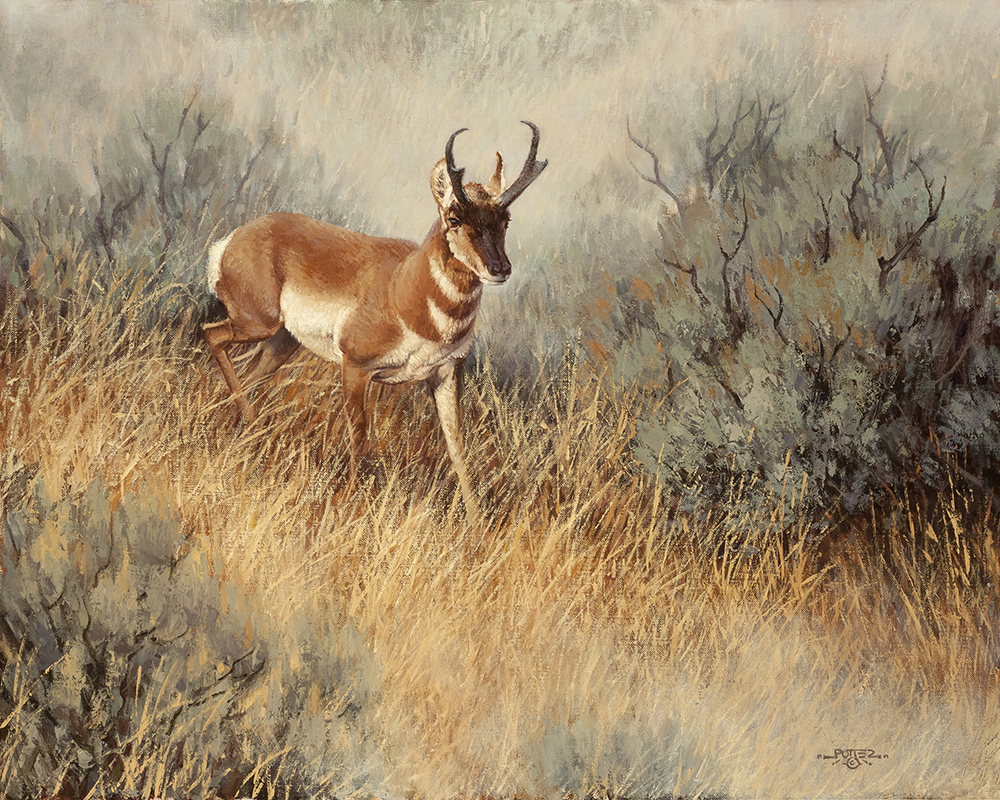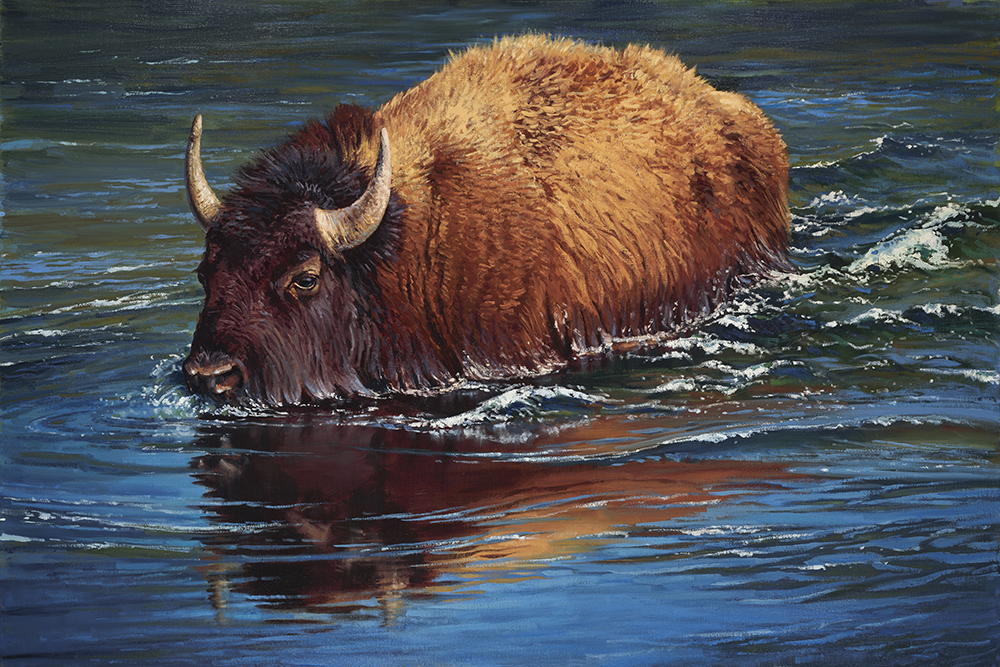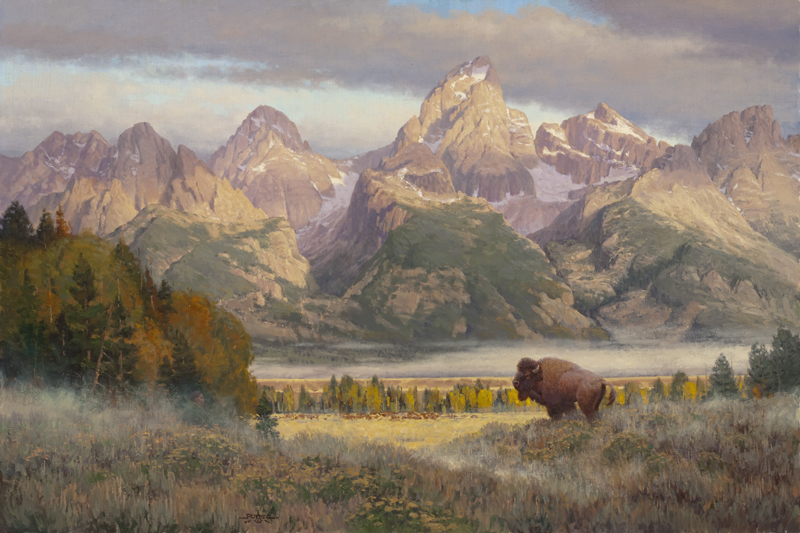Hunting as a Sacred Experience
August 30, 2022



 SCA Articles
SCA Articles
John Potter paints wildlife from a space between two worlds.
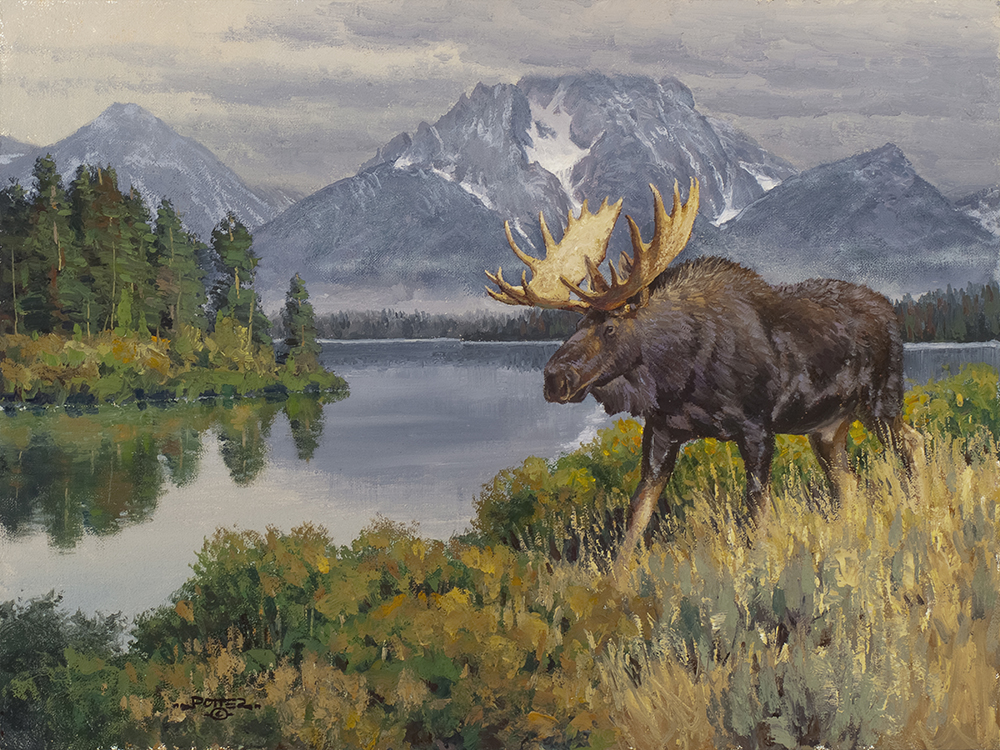
Think hard about the sporting art we hang on our walls and how its traditions are rooted in Old World European ancestry. Many Native American artists don’t paint wildlife the same way non-indigenous people do, or vice versa.
John Potter inhabits a space between, straddling the duality.
Potter, who makes his home near the rugged slopes of the Beartooth Mountains in Red Lodge, Montana, is lauded as a visual storyteller.
No words are necessary to accompany the scenes he creates. His narratives involve dramatic portrayals of natural history.
Often the stars on center stage are charismatic megafauna he has observed or imagined roaming the American West and the Northwoods of his youth. To those who collect his work, his oil paintings are as coveted as any trophy on the wall.
In the painting titled Ravenous, for example, a grizzly bear arrives on the carcass of an elk that may have succumbed to winter elements or perhaps a pack of wolves. The bear, fresh out of hibernation, sniffed into the breeze upon leaving the den and then was steered toward its first meal of the year by ravens that were circling the dead wapiti in a spiral descent.
While Potter is also keenly aware as a hunter of what raven presence means, he says the interrelationships between species, something that has evolved over time, speaks to a deeper meaning relating to survival. “The stories that we told around winter fires in our lodges, and now today, all of us, around our wood stoves, are predominantly about relationship with the natural world. Not only of connection, but of communication and interdependence,” he says.
When Potter paints what could be construed as classic “predicament scenes” of the kind often featured in hunting magazines, they are not only about spurring the viewer to ponder their own possible encounter with an animal, but to consider broader interactions.
“I love it when people say my paintings provoke discussions in their living rooms because that’s their intent. I love it when I am told that people discover new things that previously were hidden to them the more time they spend with my work,” he says. “That’s the intent. The more time we spend outside the more we become aware, and the more aware we are, the more we see.”
Be it natural history or the oral traditions of native people, it is well known that ravens work cooperatively with bears and wolves and with many others in a “community,” Potter explains. After a human hunter takes an animal and field dresses it, what’s left behind attracts scavengers and fuels a richness in the landscape.
Potter’s own hardscrabble backstory is one that his shy demeanor seldom allows him to tell. His upbringing gives him a place in contemporary wildlife and sporting art markedly different from most painters and sculptors. During his life, his translation of personal experiences is what lends something extra to his work and finds resonance in the hearts of many hunters.
“Sustenance means more than gathering meat to nourish the body. It is part of the gratitude I feel when I am in the outdoors, in places so much larger and more powerful than my ability to perceive everything that’s happening in them around us,” Potter says. “I am in awe of the opportunity that’s been given to me to inhabit this world, and part of that is being thankful to the non-human beings I share it with. If my art does anything, I hope that it honors them.
“There would be no hunting without wildlife, and no wildlife without habitat, no habitat without conservation—and no conservation unless humans acknowledged the rights and needs of other species to exist. That isn’t a new or recent ethic,” he says, “it’s one that approaches ancient attitudes toward co-existence that go back millennia on this continent.”
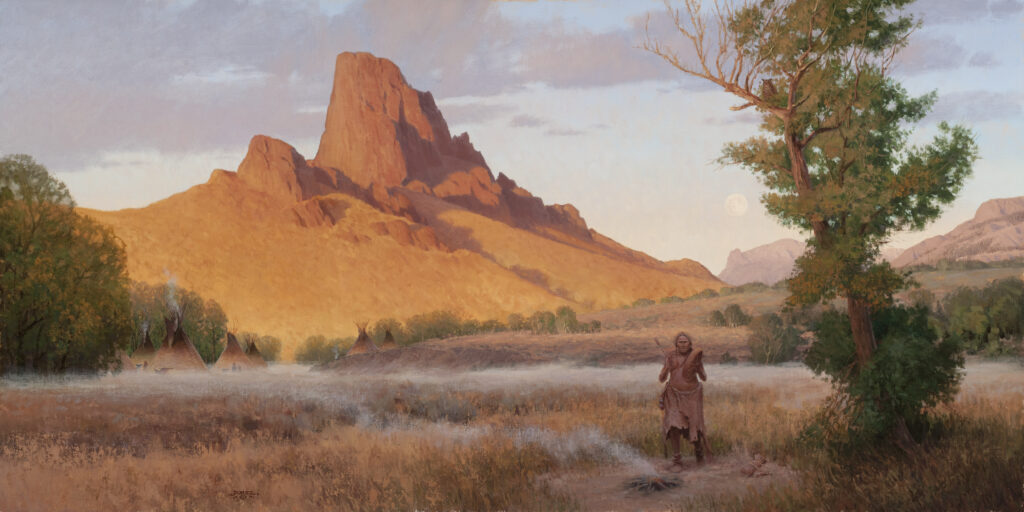
Born in 1957, Potter is not the product of an effete art school, nor is he a snowflake. Son of a white working-class mother, a World War II Marine veteran, and a father with indigenous ancestry whom he doesn’t remember, he divided his youth between the Chicago metropolitan area and the Lac du Flambeau Ojibwe Reservation in Wisconsin. While in the Northwoods, sent there by his stepfather to keep him out of trouble, he learned the true meaning of subsistence. He hunted whitetails, ran a trapline, speared muskie in a spear house on frozen lakes, caught walleye and helped harvest wild rice and maple sugar.
As a socially awkward and introverted kid, he says he spent most of his early years away from people and in the embrace of the forest and its wild inhabitants. Potter once noted, “My family likes to joke that I was raised by wolves. I should be so lucky.”
During his teenage years, he went on field trips to the Art Institute of Chicago and got his first glimpse of fine art executed at the highest levels. Summers were spent at Fond du Lac and there he fell under the tutelage of an Ojibwe artist a generation older named Nick Hockings. It is common in Indian Country that older men who take younger men under their wing to mentor them are referred to as “uncle” even if they are not directly related to each other by blood.
“Uncle Nick was the man in my life. In the absence of having a father, he filled that space,” Potter says. Besides hunting, spearing fish and snaring rabbits together, Potter says that Hockings painted on stretched deer hides and frames made of birch saplings. “His skills were with observing nature and blending with it; being with it quietly and teaching me how to be calm, and from that comes a sense of stillness and oneness.”
Potter made sense of what he encountered in nature by interpreting it in his sketchpad, which he carried everywhere. Back in the Chicago suburbs he continued taking art classes and lifting weights. He became a star running back and broke rushing records on the Barrington High School football team, attracting attention from Big 10 recruits. In his senior year, he suffered a dream-crushing injury to his spine and, again, he turned to creating art for solace. During one memorable studio painting class, his instructor called him out and said he was a fool to believe he might even pursue a career in fine art.
He said the combination of those events broke his spirit and for a time he “ran with the wrong crowd” getting into trouble. The irony is that he graduated in the top five percent of his graduating class of 700 students. Back at Lac du Flambeau, Hockings gave Potter a dose of tough love.
He told him not to retreat to the reservation; that his future was waiting for him elsewhere.
Always relishing his days in the woods spending time among animals, he considered a career in wildlife science, so he headed west and enrolled at Utah State University in Logan, Utah, because it had a fine reputation for turning out wildlife biologists.
As fate would have it, the university also had an excellent fine arts program. Naturally, he hung out with classmates in studio painting, illustration and design classes. He switched majors and graduated with degrees in fine arts and illustration. During a trip to Los Angeles to meet with graphic design firms, he carried a sketchbook that caught the attention of a top-flight art director who offered him an $80,000-a-year job on the spot.
He declined because by then he was married and had a young child. He regretted the move and his wife lined him up with a job at a bentonite mining plant in Wyoming. On the job one fateful day, an accident happened and he sustained severe injuries to his body and scalp.
As he recuperated, a friend told him about an opening at The Billings Gazette newspaper as a graphic artist and illustrator in the news division. He took it and along the way became the paper’s chief cartoonist, even being nominated for a Pulitzer Prize. Again, he never stopped painting. Whenever he could he’d be outdoors learning how to paint plein air and taking workshops from many of the premier western landscape and wildlife painters of the day. Eventually collectors took note of his paintings, too, and, via word of mouth, his reputation grew.
Potter was in his 50s when Hockings left this world. He cut his braided hair at the funeral as traditional warriors had done for generations. “It is a symbol of mourning,” Potter says in reflection, reluctant to discuss the ceremony in detail. “Our hair carries our spirit, carries our DNA from the beginning. It is about letting go and grieving the passage of someone you love who is making the journey home to be with our long-ago people. For me personally, it meant withdrawing from life for awhile.”
Amid that sabbatical he didn’t make any paintings for gallery sale and tried to recenter himself. When he returned, those who have followed his career say he was painting stronger with more powerful visual impact than ever. The chip that he carried on his shoulder had begun to wane, somewhat.
While having his work included in the annual Western Visions Show at the National Museum of Wildlife Art in Jackson Hole, Potter’s paintings came on the radar screen of museum trustee, Lynn Friess, wife of the late renowned investment guru, political conservative and gubernatorial candidate in Wyoming, Foster Friess.
The Friesses started collecting Potter’s work, which they hung in their home alongside of masterworks by Thomas Moran, Albert Bierstadt and others.
“The joy of collecting John’s work has been a combination of knowing him as an artist and understanding how he pours his whole being into a painting. His drawings are marvelous, so are his small paintings,” Lynn Friess says. “As he is able to do with his animals, he catches the essence of a mountain or a tree. Knowing how he feels about nature and the open spaces of the West, I think he brings an integrity in thinking how we can better take care of our surroundings and the environment. The native nations were the first conservationists on the continent and he imbues that spirituality in his work.”
Several years ago a competition was held at the National Museum of Wildlife Art to select an illustrator for a series of children’s books Mrs. Friess was writing. The series features a character named Carl the Chipmunk to mirthfully educate kids (and their parents and grandparents) about art, conservation and wildlife. Five talented contemporary artists were in the running and Potter was selected.
“He is a good guy, a hell of a painter and remarkably modest, given his success,” says Angie Payne, co-owner of Santa Fe Trails Fine Art Gallery (formerly Mountain Trails Fine Art). Payne and her husband, Vic, a sculptor and hunter, have featured Potter’s work at three different galleries they’ve operated “and he’s always been a favorite of our clients.”
Over the past two decades, Potter’s paintings have been acquired by museums as part of their permanent collections and he’s been invited to be part of prominent traveling exhibitions and shows at the National Museum of Wildlife Art, the Whitney Gallery of Fine Art at the Buffalo Bill Historical Center, the Denver Art Museum, Bradford Brinton Museum near Sheridan, Wyoming, Hiram Blauvelt and shows staged by the Society of Animal Artists.
The other day when Potter and I were talking, he neglected to mention that the Prince of Jordan had enlisted him to illustrate of a new book about how having a closer relationship with nature improves personal happiness. The prince had met Potter when he was the selected artist in residence in Yellowstone National Park and they’ve maintained a friendship.
“John and his art appeal to people from all walks of life and it’s so typical of him to just come across as an average guy when, in fact, there’s so much depth to who he is,” Angie Payne said.
One of Potter’s “closest painting amigos” is Ralph Oberg, known for his wildlife and western mountain scenes. “We share so much in common in our personalities and love of the natural world. I’ve been fascinated by his traditional spiritualism and love being around him,” Oberg says, noting that they’ve gone on research trips to the Wind River Mountains of Wyoming and Alaska to gather reference material for paintings. “The bonding of being out in the wilderness together is a way of creating deep experiences to draw upon.
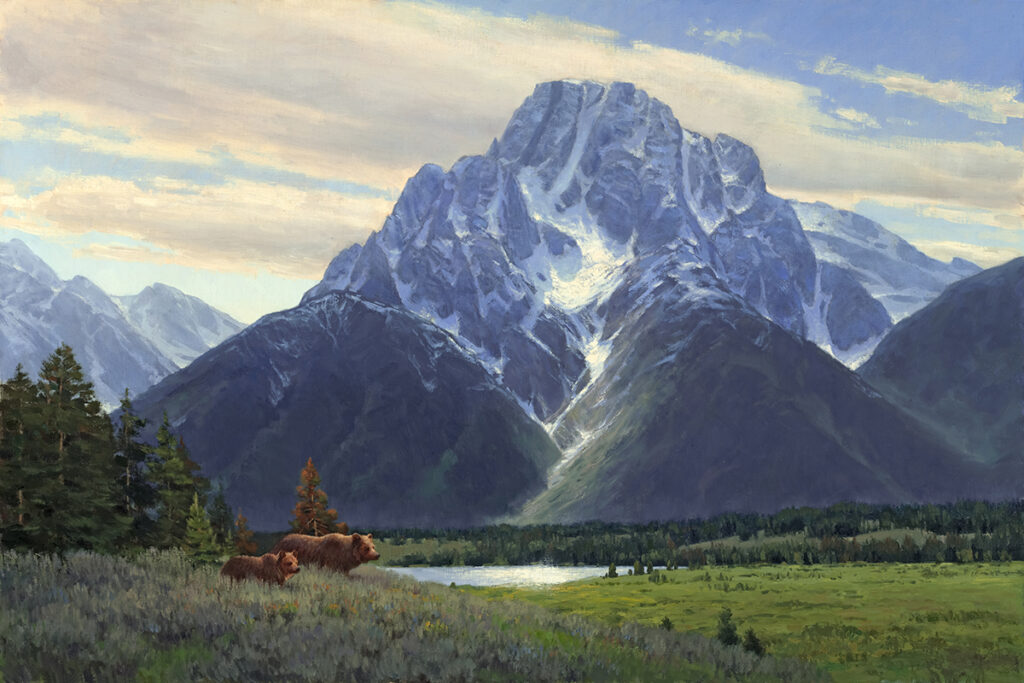
“Landscapes can be magnificent all their own, but vacant ones without their original megafauna often lack soul,” Oberg says, noting that he’s confident readers of this magazine understand keenly the point he is trying to make. “Wild animals add a whole other level of excitement. I love the peaceful quiet of mountain landscapes, but when there are mountain goats or sheep or bears moving around it intensifies the experience.” It is that sense of expectation that, when infused into a painting, delivers something to the viewer over and over again.
Generational shifts in attitudes toward art have created hard times for painters today who portray wildlife realistically or even impressionistically. While some largely-urban and younger collectors prefer abstract depictions of wildlife in which being able to recognize an actual animal isn’t important, hunters and anglers remain drawn to classic game scenes executed with a high level of virtuosity.
Drawing upon Ojibwe oral traditions that venerate wolves, including establishing special wolf clans, Potter in Out of the Blue uses his sophisticated grasp of palette, composition, light and shadow to depict an animal that is venerated in the culture. “Wolves were only hunted by those who had the right—by spiritual guidance—and then, and only then, for medicine [visions that yielded lessons important for individuals or the tribe].”
With the work, Mist Opportunity, which was sold to a collector at the 2018 Southeastern Wildlife Exposition in Charleston, South Carolina, a pronghorn buck ambles down a game trail through the western sagebrush. The painting definitely has an Old-World impressionistic feel to it. “It was not only predator species that held our awe and fascination. So-called prey species had much to gift us with as well, if we were patient enough to observe, and listen,” Potter says. “We watched, and learned, as relatives like this prairie runner would take advantage of atmospheric conditions and variety of terrain to escape detection and remain virtually unseen in what would normally be thought of as the ‘featureless landscape’ of the plains.”
And with In The Presence, a cougar suns and scouts for its next meal in a red rock boulder field. Look closer in the brush and one will see the subtle shapes of medicine bundles left by questers who sought out the same remote spot to pray. “This lion has paused here in a place shared by many who had fasted nearby in the past, and left offerings as thanks for their communication and instruction imparted by the spirits. The cat is hunting in the presence of the sacred.”
Potter says that readers of Sporting Classics understand what he means by the outdoors as a sacred experience that is part of the memory passed down from one generation to the next. He further adds, “In our creation stories, we’re told that our bodies were made out of the mud of the earth, as were the bodies of all the animals who came before us. We are made of the creatures that we live among, that we learn from, that we hunt.”
“For me, whether hunting for meat or for photos,—or for therapy to cope with stressful modern lives, being out in the wild is about honoring that pact, that kinship, that interrelationship, that bond and connection. It’s about being open to what the land has to tell us or teach us if we listen with our hearts. It’s about hearing the songs of our own beginnings in the bugle of an elk, the roar of a waterfall or the silence of the stones. Gakina awiiya—in our language—means ‘we are all related.’”
This article originally appeared in Todd Wilkinson’s column in the May/June 2022 issue of Sporting Classics magazine.
